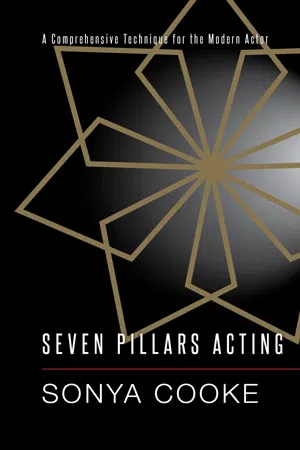![]()
Pillar #2
Acting is living truthfully under imaginary circumstances.
—Sanford Meisner
If Contact is the foundational pillar, then Circumstance is the luminous, central one. Its significance radiates throughout the structure and illuminates the other pillars. Circumstance holds up the ceiling, which is your effortless and truthful performance, and is the core of this method. Everything you learned in Contact was meant to prepare you for this pillar. You now grasp the value of a moment-to-moment relationship with another person, and Circumstance extends from this basic premise. In this pillar, we will begin to explore our character’s circumstances, which revolve around the connection shared between two partners. The Circumstance pillar is not an intellectual exercise; each circumstance is an opportunity to activate the imagination and translate it into your contact.
Circumstances are more a series of questions than an accumulation of answers; they are the beginning of the conversation. Avoid boxing yourself into choices without allowing yourself a period for discovery. Circumstances are a point of departure.
Circumstances: the facts, events, actions, and details taking place in the past, present, and future, exclusively from the character’s perspective.
Anything that happens to the character is a circumstance. An emotion is not a circumstance, but the emotions of others definitely are.
When playing a fictional character, it is a misunderstanding to think we are merely dealing with fiction. We should treat our fictional characters as we do our historical ones. Typically, when an actor portrays a “real” person, living or dead, he feels responsible to uphold the truth of that individual’s life. Inauthenticity in the performance of a historical character is disrespectful, and ignorance of his or her life is unacceptable. However, for some reason, this sentiment is not the same in how we regard fiction, which is a big mistake. Even though our characters were dreamt up in the imagination of the playwright or screenwriter, something like these life experiences has likely occurred in real-time to someone. Or are we actually going to believe that in the thousands of years of human existence this one scene has never played out in a more or less similar fashion? Even science fiction and fantasy are based on fundamentally human experiences. I bet, at the very moment you are reading this sentence, scenes like the one we’ve been studying in You Can Count On Me are playing out at the same time in at least ten different places all over the globe. There is a core of universal truths in the works that attract our attention. Therefore, we can lend these circumstances some credence. Let’s start off on equal footing with our characters by valuing their experiences as we value our own. By respecting the character’s circumstances, we can start to believe them. The next step in leveling out the playing field is debunking the “reality” of our world.
Reality is merely an illusion, albeit a very persistent one.
—Albert Einstein
Robert Cohen was one of the first acting theoreticians to problematize the issue of our grasp on reality:
Reality is not a very simple concept to define. Certainly we can agree that reality includes trees, birds, rocks, the human skeleton, and the sky; but what place in reality do dreams, feelings, numbers, love, or despair occupy? They are real if only because we feel they are real; their realness, though subjective, is as influential in our “real” decisions as hard and fast tangible reality.8
One thing that makes our reality seem real is that we believe in it, and, because we believe it, it feels real. Reality is felt, while imaginary circumstance can only be imagined in the mind. Once a circumstance is known to be imaginary, its potency is gone—much like being spooked by a shadow in a dark corner. Once it is revealed to not be a real threat, the fear subsides. Therefore, because of the degree of belief, the circumstances of our lives seem more real than the circumstances of our characters. Therefore, the distinction between these sets of circumstances, one’s own and one’s character, is the degree and fervency of belief. Maybe by considering life more subjectively and taking our experiences more lightly, we may be able to let them go long enough to relate to another set of circumstances.
In my own life, I have witnessed how mere thought has the power to transform circumstances. Shifting thought feels like turning a corner: the road changes and the horizon is brighter or darker, depending on the thought in mind. My perspective, life-stories, past experience, and emotions cloud and color the canvas that is my life. This concept is a philosophy or system of faith for some, but it’s also a hypothesis tested by researchers across disciplines. The circumstances of our lives can, therefore, be as illusory as the circumstances of our characters. What are the circumstantial differences between your and your character’s lives? Likely, there are many differences and some similarities, but, regardless, consider them of equal value and substance...
